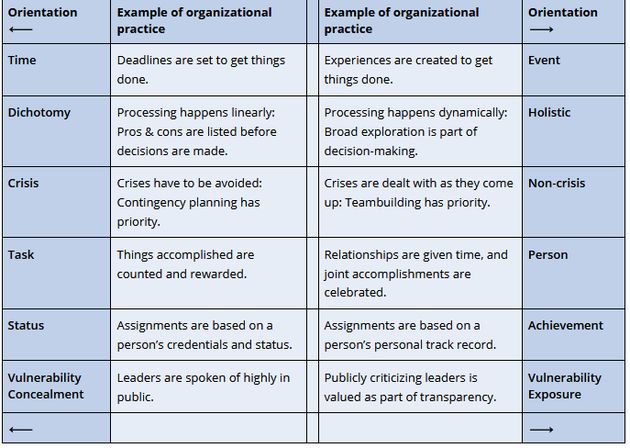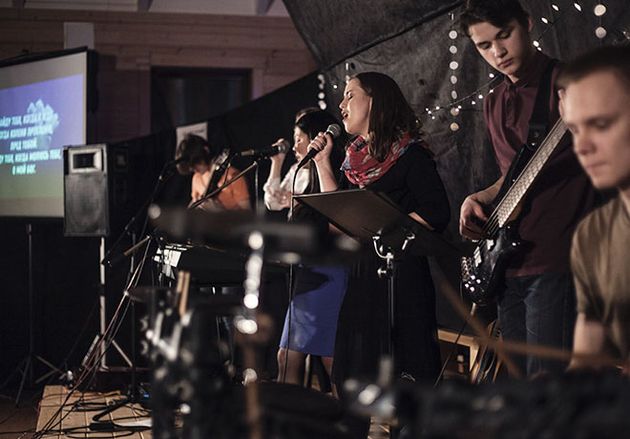Toward a ‘third culture’ of oneness in Christ. An article by Kirst Rievan.
![Image via [link]Lausanne Movement[/link].](https://cms.evangelicalfocus.com/upload/imagenes/6034048b1a716_lgauncovering.jpg) Image via [link]Lausanne Movement[/link].
Image via [link]Lausanne Movement[/link].
The death of George Floyd in the US caused quite a bit of discussion in the leadership team of which I am part: How much do we personally or as an organization unintentionally discriminate against staff and partners of different ethnicities?
Particularly when we started to look at our practices and systems, we discovered there is still much work to do. I would like to take you along on my journey toward discovering how metaphors and models can trigger much-needed conversations about the often-hidden systemic discrimination in the mission movement.
Every Sunday here at our church in Asia, guitars are tuned, sound systems checked, and mics tested. Those things are very similar to what happens in my home church in Europe (at least before COVID-19).
However, there is one big difference: nobody is scrambling to find their sheet music—not because they have the music on their electronic devices, but because they do not use sheet music at all.
They just play. Someone starts the selected song in a key that he or she likes, and the others follow. If it is too high or too low, they just change it. Neither the players nor the congregation seem to have a problem with that.
Over time, I have adjusted to it somewhat and have learned to play my guitar by heart rather than from music. I am still not good at it, but I am learning.

Recently we visited with a good friend here who, as an Asian, works in an international organization. She exclaimed how difficult it was last year for her to prepare for a workshop with a European on the team.
With a gracious smile, she said something like: ‘This European wanted everything to be so precise, everything so documented; we as Asians felt suffocated.’ The European was creating ‘sheet music’, while our friend wanted to create ‘songs’.
Mission organizations are often placing more people from different cultures in leadership with the expectation that this will automatically make the organization multicultural. By doing that, we fail to understand that much more is needed. In many cases, it tends to lead to an unequal playing field.
If, for example, this new leader comes from a culture that makes beautiful music without sheet music, cooks delicious food without recipes, and works effectively without a calendar, they will feel quite stretched when expected to lead effectively in an organization that only makes ‘music’ with ‘sheet music’.
The organizational culture is in effect ‘discriminating’ against this leader as it may hamper him or her from flourishing, while feeling ‘suffocated’.
As the early church was shaping itself, the Jewish Christians wanted the new pagan believers to adapt to their practices. Particularly in the letter to the Colossians, we read how strongly Paul feels that judgment based on customs and rituals is wrong: ‘Therefore do not let anyone judge you by what you eat or drink, or with regard to a religious festival, a New Moon celebration or a Sabbath day.’
Instead we should ‘set [our] minds on things above, not on earthly things’ (Col 2:16; 3:2; NIV). It calls for a mind open to different ways of functioning.
With regard to ‘discrimination’, we see an early example in Acts 6 where the non-Jewish widows felt neglected. Soon a committee was established to stop the unfair treatment based on their ethnicity.
Also, in the epistles Paul emphasizes that all are equal in Christ: ‘There is neither Jew nor Gentile, neither slave nor free, nor is there male and female, for you are all one in Christ Jesus’ (Gal 3:28, NIV).
That brings us to a definition of discrimination based on these biblical references. For this article I define ‘discrimination’ as treating people in a disadvantageous way based on their ethnicity.
In thinking about how to remove systemic organizational inequality, it is helpful to consider making use of cultural dimensions. There are several sets of cultural dimensions,1 which can be used for this.
I choose to use the dimensions developed by missiologist Sherwood Lingenfelter, as those are based on researching mission settings. Lingenfelter 2 states that you can describe each culture basically around six dimensions:
- Time versus event orientation
- Dichotomistic versus holistic thinking
- Crisis versus non-crisis orientation
- Task versus person orientation
- Status versus achievement focus
- Concealment of vulnerability versus willingness to expose vulnerability
Part of opening a conversation around inequality is for people to understand themselves and others to this end. Each person could be encouraged to do the ‘Basic Values Questionnaire’ that Lingenfelter developed.
That way we can plot ourselves on the dimensions and then discuss how, as a team, we can adjust our practices related to these six dimensions to make everybody feel welcome and appreciated.3
More needs to happen than just identifying our personal cultures. In many mission organizations where a significant number of staff and financial resources come from a particular founding culture, leaders do not realize how dominant that home culture is.
Nicholls states in his dissertation on Leadership and Cultural Hegemony about a mission founded in America: ‘The fact that many [minority leaders] have been able to adapt has concealed the reality that, for many minority culture leaders, even those from Western countries, in order to function effectively in [the organization] one must put aside many cultural values and become more American.’ 4
From my experience, I would say that such dominance is not just present in organizations founded in the West. I have seen similar struggles in organizations founded in the Global South when they attempt to recruit people from different people groups.
The cultural dimensions mentioned above can also be used to discover our organizational culture and determine how much it is dominated by a particular culture. To make this concrete, I have provided some organizational practices related to each cultural dimension in the table below.

Plotting our own organization on these dimensions, preferably with a diverse group of colleagues, can trigger a rich discussion, resulting in a discernment process on our organizational identity—who we are, what our common values are, and how we can create a ‘third culture’ in which we can all feel equally at home.
My wife and I have two sons who are clearly ‘third culture’ kids. They grew up in a country other than their passport country. They are neither fully part of the host culture nor part of their home culture. Together with their friends they created a ‘third culture’ of kids.
This concept of third space is increasingly used in mission circles. Franklin 5 describes it as a neutral place between the powerful and influential organizations in the West and the emerging mission organizations in the majority world.
Likewise, we can talk about a third organizational culture—a place where we together decide how we do things. A place where we all are willing to feel ‘appropriately uncomfortable’ and likewise are willing to contribute to the common culture to enrich it and make it a place where we can also equally feel at home and flourish.
Engaging together with all staff in missiological reflection on what all of us value can be a good start for creating this third space. Once that foundation is laid, a lot of things will fall into place. Can we create a third culture for our organizations that is flexible enough that, when new people are added, their cultures are further enriching it?
As ‘culture eats strategy for breakfast’ 6 it is important that we change our ways of working to create such an organizational third culture. The organization which I work with is far from having arrived. Still, the following are a few examples from the journey we have started:
Conferences: For large group gatherings, we have moved away from open mic time to processing in small groups. This has helped to enable colleagues from cultures that conceal vulnerability to engage much more deeply.
Community building: We have started a corporate drive for community building, and we encourage each unit to spend more time fellowshipping and praying together, even if it must be virtual. This has been particularly resonating well with person-oriented cultures.
Planning: We have moved our planning process from a focus on forms and deadlines to a ‘Reflective Planning Cycle’ with more emphasis on the process and less on the outcome. This has been particularly helpful for event-oriented cultures.
Income: Practices and policies have been changed to close the gap between supported and salaried staff. We still have a long way to go on this, but the process is highly appreciated by colleagues from most host countries.
Localization: Units in each country are forming local boards and appointing more people from that country or region to leadership positions. The hope is that gradually this, together with all other measures, will address the need for more diversity in all dimensions while also keeping the world-wide church engaged.
To fuel such a change process, some reflection on the following might be helpful:
Biases: What are my personal biases concerning certain cultures that I need to deal with? What biases do we as an organization have that we need to address?
Equality: What do we mean when we say that all our staff members should experience oneness in Christ? Whom do we include in our definition of ‘our staff’, and what do we mean by ‘oneness in Christ’?
Organizational culture: What is the most dominant culture in our organization? What could an organizational third culture look like where all can feel equally ‘appropriately uncomfortable’ and at home?
Leadership appointments: What do we need to change in the functioning of the leadership team to make it more welcoming to leaders from a non-dominant culture?
Systems: What can we change in our finance and HR systems to make the playing field more equal for colleagues and applicants from non-dominant cultures?
Celebration: What diversity have we already reached that can be celebrated?
Grappling together with these questions will take time, will require a lot of prayer, and cannot be done in a linear way. Questions we thought we had solved a while ago might need to be revisited. But through such a process, equality can be increased in our organizations.

A couple of weeks ago, I was working with a colleague from Asia on the preparations for a team meeting. We discussed how to put the idea of ‘worship without sheet music’ into practice.
My colleague suggested we would do an experiment. For the first two hours on day one we would not have any agenda. We called it ‘inefficient lingering’. 7 By doing that, we wanted to create space.
Space for the different cultures in the team, but particularly space for the non-dominant culture in our organization. As a result, we had a great time during which we learned all kinds of things about each other’s upbringing, spiritual lives, families, and cultures and, after that, we got through a good part of the agenda in a quite open way!
The goal is not to go from domination by one culture to domination by another, but to create equal space for all staff. That would become a beautiful orchestra[8] where we all play in harmony and a beautiful melody is created together with and without sheet music.
Kirst Rievan (pseudonym) and his wife are from Europe and have been living in Asia for over 20 years. Kirst provides leadership in Asia and Pacific for a global faith-based development organization.
Kirst considers himself a 'reflective practitioner', a fellow-learner, but not an expert. Kirst has a doctorate in missiology from BIOLA University.
This article originally appeared in the January 2021 issue of the Lausanne Global Analysis and is published here with permission. To receive this free bimonthly publication from the Lausanne Movement, subscribe online at www.lausanne.org/analysis.
1. The best known cultural dimensions are the ones developed by Hofstede. See Geert Hofstede, Jan Hofstede, and Michael Minkov, Cultures and Organizations: Software of the Mind (New York: McGraw-Hill, 2010). The advantage of using those is that there are plenty of tools and indexes available to help you analyze the cultures you want to study. However, as those tools are all developed for businesses, I chose the Lingenfelter set for this article.
2. Lingenfelter’s dimensions and the Basic Values Questionnaire are described in a small book which is widely available on the internet: Sherwood G Lingenfelter and Marvin K Mayers, Ministering Cross-Culturally: An Incarnational Model for Personal Relationships (Grand Rapids,: Baker Academic, 2016). See also: Lingenfelter hand-out.
3. Editor’s note: See article entitled, ‘Becoming a Healthy Multi-cultural Team’, by Scott Moreau in the March 2019 issue of Lausanne Global Analysis, https://www.lausanne.org/content/lga/2019-03/becoming-a-healthy-multi-cultural-team.
4. David Nicholls, Leadership and cultural hegemony: The experiences of minority culture leaders in multicultural SIL (Melbourne, 2018): 167.
5. Kirk Franklin, ‘Leading in Global-Glocal Missional Contexts: Learning from the Journey of the Wycliffe Global Alliance,’ Transformation: An International Journal of Holistic Mission Studies 34 (4), (August 2017): 282–300, https://doi.org/10.1177/0265378817724343.
6. ‘Culture eats strategy for breakfast’ is a phrase originated by Peter Drucker (1959) and made famous by Mark Fields, President at Ford.
7. Ajith Fernando used the term ‘inefficient lingering’ at a mission conference in 2012 to challenge the task-oriented missionaries to spend more time with their colleagues from people-oriented cultures.
8.This is a reference to the orchestra metaphor Timothy Tennent uses in his book Invitation to World Missions: A Trinitarian Missiology for the Twenty-First Century (Grand Rapids: Kregel Academic & Professional, 2010).

Las opiniones vertidas por nuestros colaboradores se realizan a nivel personal, pudiendo coincidir o no con la postura de la dirección de Protestante Digital.
Si quieres comentar o